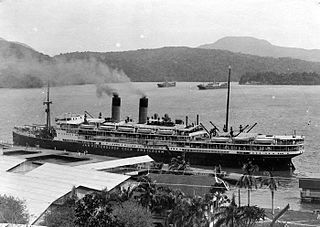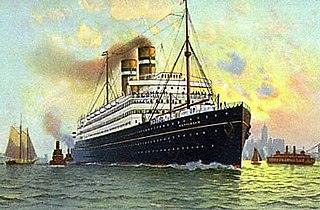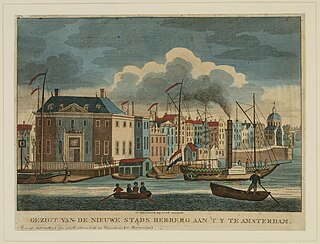
Stoomvaart Maatschappij Nederland or SMN, also known as the Netherland Line or Nederland Line, was a Dutch shipping line that operated from 1870 until 1970, when it merged with several other companies to form what would become Royal Nedlloyd.

The Rotterdamsche Droogdok Maatschappij (RDM) was the largest pre-World War II shipbuilding and repair company in Rotterdam in the Netherlands, existing from 1902 to 1996. It built 355 mostly major seagoing vessels, 18 of which were submarines. During its existence, the wharf operated 12 floating docks and in its heyday employed 7,000 people at one time.
SS Antenor was the first of five ships to bear the name. She was built in 1872 by Hawthorn Leslie and Company at Hebburn-on-Tyne. She was built for Alfred Holt and Company, who owned various shipping lines including the Ocean Steam Ship Company (OSSC), Nederlandsche Stoomvaart Maatschappij Oceaan (NSMO), The China Mutual Steam Navigation Company (CMSNC) and Blue Funnel Line. SS Antenor had a gross registered tonnage (GRT) of 2,074, was 322 feet (98 m) long, had a beam of 33 feet 7 inches (10.24 m) and a service speed of 10 knots. She was powered by a single screw, two cylinder compound tandem steam engines; 214 NHP, 700 IHP. Her sister ships were SS Deucalion (1872), SS Glaucus (1871) and SS Patroclus (1872).

Pieter Corneliszoon Hooft was a Dutch ocean liner built in 1925. An onboard fire destroyed her passenger accommodation before she was completed. In 1932, another fire damaged her so severely that she was sold for scrapping, only to catch fire again before she was scrapped.

Stoomvaart Maatschappij Zeeland was a Dutch ferry operator that ran services from the Netherlands to the United Kingdom between 1875 and 1989.

SS Prinses Amalia was a Dutch steam ship of the Netherland Line

SS Jan Pieterszoon Coen was a Dutch passenger steamship that was launched in 1914. She was named after a former Governor-General of the Dutch East Indies. During the German invasion of the Netherlands in May 1940 she was scuttled as a blockship in the port of IJmuiden, North Holland to prevent the Kriegsmarine from using the port.

The SS Lakeland was an early steel-hulled Great Lakes freighter that sank on December 3, 1924, into 205 feet (62 m) of water on Lake Michigan near Sturgeon Bay, Door County, Wisconsin, United States, after she sprang a leak. On July 7, 2015, the wreck of the Lakeland was added to the National Register of Historic Places.

SS Rotterdam was a steam ocean liner that was launched and completed in Ireland in 1908, and scrapped in the Netherlands in 1940. Holland America Line (HAL) owned and operated her throughout her career. She was the fourth of seven HAL ships to have been named after the Dutch city of Rotterdam. Until Statendam entered service in 1929, Rotterdam was the largest and swiftest ship in the company's fleet, and was the company's flagship.

The Riouw class was a class of four steam screw gunvessels of the Royal Netherlands Navy. They were the first composite built ships of the Dutch navy.

Volharding Dock, was a floating dry dock built for the Nederlands Indische Droogdok Maatschappij (NIDM) in the 1870s. It was the smallest of two unique tower dry docks, and the only one that would actually be put in use.

Batavia Dock, was a floating dry dock built for the Nederlands Indische Droogdok Maatschappij (NIDM) in the 1870s. It was the biggest of two unique tower dry docks, but would never be used.

SS Willem III was the lead ship of the Willem III class, and the first ship of the Stoomvaart Maatschappij Nederland (SMN). She was burnt on her maiden trip. Later the wreck was repaired and sailed as Quang Se, Glenorchy and Pina.

SS Prins van Oranje was the second ship of the Willem III class. It was the first ship of the Stoomvaart Maatschappij Nederland (SMN) that completed a round trip to the Dutch East Indies.

SS Prins Hendrik was the third ship of the Willem III class. She was the second ship of the Stoomvaart Maatschappij Nederland (SMN) and was lost after barely two years of service.

Amsterdamsche Droogdok Maatschappij (ADM) was a Dutch company that repaired ships using dry docks in Amsterdam, Netherlands. After World War II it also built some ships.

Amsterdamsche Stoomboot Maatschappij was an early Dutch steam shipping company.

SS Costa Rica was a Dutch passenger steamship. She was built in 1910 as Prinses Juliana for Stoomvaart Maatschappij Nederland, which ran scheduled passenger and mail services between Amsterdam and Java.

SS Koningin der Nederlanden was a Dutch passenger steamship. She was built in 1911 for Stoomvaart Maatschappij Nederland, which ran scheduled passenger and mail services between Amsterdam and Java.

SS Aquileia was a Dutch-built steamship that was launched in 1913 as the ocean liner and mail ship Prins der Nederlanden for Netherland Line. She ran scheduled services between Amsterdam and the Dutch East Indies until 1930, when she was laid up.




















